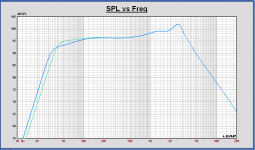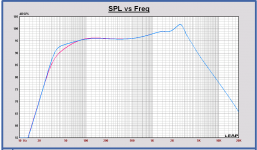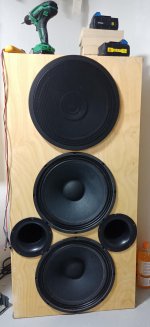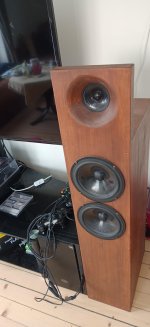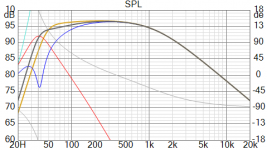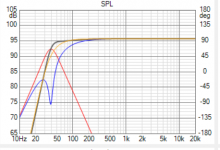- blue curve: VB = 120 L, FB = 38 Hz; larger volume and same FB as Monkey Coffin (shorter port)
Thisone looks nice, as the SPL is pretty much the same as the original Monkey Coffin above cut-off.
Could you also do one with VB at approx. 90 L?
In all cases with larger volume, you have to adapt the RLC circuit parallel with the woofer, because the location of the higher impedance peak is different.
Yes! The corresponding changes in the xover be relatively straight forward (just adapt the L or C values in the compensation network).
Yes I can do VB = 90 L or let us take the VB value that Don has in mind.
Than we can optimize for the best FB value and port.
Adapting the X-over for the new BR is not much work. We can do a simulation for the best fit on the existing Monkey Coffin SPL for higher frequencies.
Than we can optimize for the best FB value and port.
Adapting the X-over for the new BR is not much work. We can do a simulation for the best fit on the existing Monkey Coffin SPL for higher frequencies.
The curve shows a SPL decrease starting at about 150 Hz down to about 40 Hz. If this is due to the bass-reflex tuning (i.e., "just the woofer+box acoustics"), the bass output between 150 Hz and 40 Hz or so will be less than with the original Monkey Coffin box, which has a flat SPL curve in this range.
I will take the time to look into the sims properly later today, but for now I have just a little bit of time to reply to this in regards to "basics of bass reflex".
The driver is merely a lone 12", with limited membrane area and xmax.
1. If the box is small you get a stronger "air-spring" effect, more or less regardless if it's vented or closed, this can help to adjust spl to a limited extent at certain frequencies.
2. Any changes to volume = changes to tuning and vice cersa. This in turn changes any impedance behaviour because they're all connected by way of physics, or "majick" if that is a more suitable term.
3. Because of #1 and #2: Port output will also help affect higher frequencies more if the box FS is closer to driver FS.
Long story short:
If you want a vented design with well behaved, flat, predictable behaviour from any kind of driver, you should find a driver with a QTS of 0,33-0,35 and make a box close to VAS in size tuned to driver resonant frequency or just below.
QTS is literally the "total sum" of Q values, these values tell us something about specific qualities of a driver, mechanical and electrical losses spesifically around driver FS. VAS is a value that tell us a bit about driver behaviour in free air (or "close to" free air, commonly somewhere around 1000 liters is used for some of these measurements), it is by no means a recommendation of box volume but can give a general indication of such.
Thiele / Small (T/S) Speaker Parameters
But you *can* completely ignore all this and make any kind or size of box with any kind of driver, it's just more fiddling to get it right. Not to mention that for instance in this case, using a high efficiency 12" to make anything lower than 30hz is quite absurd. They're very rarely used below 60hz tuning for pro applications, we can get away with it because we don't need it to do 120 decibels for several hours straight.
Don, what did you want again? Want to go lower or want to go louder with your properly sized box?
I find that for a lot of modern music 35-40hz is *enough*, for a very good piano recording I need down to 26hz pending on the techniques and microphones used.
Last edited:
Great info as always Kaffiman.
Just to add to that. This particular driver, due to the way it's designed and T/S parameters is pretty well behaved. As are most pro speakers.
By that I mean as you adjust box size and port volume, it changes gradually and does so over a predictable range. So as the graphs show, going from a 68L box all the way to a 140L box doesn't do anything radical to the curves.
If you plot those over time, you'll see that at 68L your cutoff is just over 40hz and the curve is relatively flat from there to about 400hz.
If you go all the way to 140L and appropriately tune the port, you go from down around 30hz but with a gentle slope ranging about 3-4db from there to about 400hz.
If you plot many curves, you'll see that as you go bigger the knee of the curve gradually goes down as the slope of the curve to 400hz gradually changes. But the changes are gradual and fairly linear.
As you increase the box size, the way the slope changes is that the amount of the output in the low range goes down. So basically the change in slope of the curve is due to the lower end dropping down in volume as it goes lower.
As Mathias pointed out, the result of this is that you need to compensate for this by reducing the volume of everything else in the speaker to match via changes to the xover. The result of this is going to reduce the sensitivity of the speaker.
I personally think the sweet spot is around 85-90L but any of these box sizes can be made to work.
If the 1200mm height is something you like (for whatever reasons), then what I would do is take that box, and add something internal to reduce that to 85-90 and put an appropriate port in it.
gabo
Just to add to that. This particular driver, due to the way it's designed and T/S parameters is pretty well behaved. As are most pro speakers.
By that I mean as you adjust box size and port volume, it changes gradually and does so over a predictable range. So as the graphs show, going from a 68L box all the way to a 140L box doesn't do anything radical to the curves.
If you plot those over time, you'll see that at 68L your cutoff is just over 40hz and the curve is relatively flat from there to about 400hz.
If you go all the way to 140L and appropriately tune the port, you go from down around 30hz but with a gentle slope ranging about 3-4db from there to about 400hz.
If you plot many curves, you'll see that as you go bigger the knee of the curve gradually goes down as the slope of the curve to 400hz gradually changes. But the changes are gradual and fairly linear.
As you increase the box size, the way the slope changes is that the amount of the output in the low range goes down. So basically the change in slope of the curve is due to the lower end dropping down in volume as it goes lower.
As Mathias pointed out, the result of this is that you need to compensate for this by reducing the volume of everything else in the speaker to match via changes to the xover. The result of this is going to reduce the sensitivity of the speaker.
I personally think the sweet spot is around 85-90L but any of these box sizes can be made to work.
If the 1200mm height is something you like (for whatever reasons), then what I would do is take that box, and add something internal to reduce that to 85-90 and put an appropriate port in it.
gabo
It depends what kind of basreflex system you like to realize. This Faital driver has fs = 42 Hz, Qts = 0.37 and Vas = 95 L.
If you like a Butterworth 4th order high pass response, conform the R.Small graphs, you have to choose VB = 95 L and fB = 42 Hz for Qts being around 0.40. Then the repsonse is optimal flat down to F3 = 42 Hz.
If you like a more extended low frequency response, you have to choose FB lower. SPL at very low frequencies will increase, but F3 will become higher.
In the plot, two SPL responses for VB = 95 L and FB = 42 Hz - B4 response (green) vs. FB = 35 Hz - extended response(blue)
If you like a Butterworth 4th order high pass response, conform the R.Small graphs, you have to choose VB = 95 L and fB = 42 Hz for Qts being around 0.40. Then the repsonse is optimal flat down to F3 = 42 Hz.
If you like a more extended low frequency response, you have to choose FB lower. SPL at very low frequencies will increase, but F3 will become higher.
In the plot, two SPL responses for VB = 95 L and FB = 42 Hz - B4 response (green) vs. FB = 35 Hz - extended response(blue)
Attachments
I guess we're not going to do any substantial changes to the xover in order to compensate for flat bass SPL (that would be opening Pandoras box!). If you still want flat bass SPL, you'll have to tune the box for flat SPL. Looking at the model runs we have so far, I guess this means that box volume cannot be more than 90-95 L or so. If you don't care about flat bass SPL, the sky is the limit in terms of box size...
Thanks for the compliments Gabo, but I'm just a guy trying to think inside the box. Nothing special.
Well...
There's no specific rule that says a box is too big for any driver, but we can say something about where you start getting diminishing returns.
I'd say that about 120 liters is the "sanity limit" for this particular driver, around 100-110 somewhere would be optimal (I seem to remember a great sim around 106 liters).
But guys, please do not forget about port placement. It is absolutely crucial in achieving a proper result.
Well...
There's no specific rule that says a box is too big for any driver, but we can say something about where you start getting diminishing returns.
I'd say that about 120 liters is the "sanity limit" for this particular driver, around 100-110 somewhere would be optimal (I seem to remember a great sim around 106 liters).
But guys, please do not forget about port placement. It is absolutely crucial in achieving a proper result.
Last edited:
IMO, the X-over changes will be minimum, keeping the same FB = 38 Hz like the Monkey Coffin for a larger cabinet.
Look to the SPL and impedance differences of a BR in 95 L FB = 38 Hz (blue curve) versus BR in 68 L FB = 38 Hz (red curve)of the Monkey Coffin
Look to the SPL and impedance differences of a BR in 95 L FB = 38 Hz (blue curve) versus BR in 68 L FB = 38 Hz (red curve)of the Monkey Coffin
Attachments
Okay, now I got a few minutes to properly read stuff through I'm not really sure if I need to supplement any more info. Paul has posted some nice graphic representations that should, in combination with the posts from Gabo and myself, explain the stuff that Matthias asked about.
Believe it or not, but doing these sims properly actually takes a bit of time because I do run them several times in different ways to make sure there's no nasty surprises, and also to see if port placement makes any difference, especially takes time if I got to cobble together and compare several different results, some of which was done aeons ago.
Not trying to creep out of this discussion but I got to spend the sunday driving because I'm away for work the entire next week, and my wife's working this saturday so I'm just gonna call this part of the discussion "good enough" since it's already mostly covered. My wife is very patient and lets me build big 300 liter boxes (and she actually helped me a bit!) without any complaints, so I got to be nice to her sometimes as well.
Don, what kind of tuning do you want?
Oh, And I tried figuring out an acronym for Faital but I got stuck on the second A, so someone should think of that.
Believe it or not, but doing these sims properly actually takes a bit of time because I do run them several times in different ways to make sure there's no nasty surprises, and also to see if port placement makes any difference, especially takes time if I got to cobble together and compare several different results, some of which was done aeons ago.
Not trying to creep out of this discussion but I got to spend the sunday driving because I'm away for work the entire next week, and my wife's working this saturday so I'm just gonna call this part of the discussion "good enough" since it's already mostly covered. My wife is very patient and lets me build big 300 liter boxes (and she actually helped me a bit!) without any complaints, so I got to be nice to her sometimes as well.
Don, what kind of tuning do you want?
Oh, And I tried figuring out an acronym for Faital but I got stuck on the second A, so someone should think of that.
Last edited:
Hi Kaffimann, I have posted some concept proposals, but I have no idea which is the best concept to choose. I don't have practical experience with this format of ported speakers.
Are you still preferring the extended basreflex systems? I know that Avalon is using extended mode basreflex in their speakers, like the Eidolon for example. That one should have very good bass response.
I was wondering if it is a good idea to use the Faital 12PR320 in extended mode, because its fs = 42 Hz, rather high. The extended mode basreflex systems I know all have low fs transducers.
Are you still preferring the extended basreflex systems? I know that Avalon is using extended mode basreflex in their speakers, like the Eidolon for example. That one should have very good bass response.
I was wondering if it is a good idea to use the Faital 12PR320 in extended mode, because its fs = 42 Hz, rather high. The extended mode basreflex systems I know all have low fs transducers.
Hello Paul, to put it somewhat bluntly, the graphs you posted are very good for comparing tuning vs box volume which was at the core of discussion. But without specific details like dimensions and placement of drivers and port, I would just call it a rough approximation.
I have a preference, to choose the alignment that gives the best compromise.
Something like a slot port can be a good solution if you're chasing certain specific criteria, but if your design criteria and goals are different like for example exceptionally loud and clean at the same time then big aero ports are the way to go.
I haven't built a lot of speakers, and do not really have that much experience compared to some others here. But I have made tapped horns, Dipoles, IB, horns, closed, bass reflex with slotted/round/aero upwards/downwards/sideways firing ports, variations on TL/ML-TL, QWT and T-TQWT, worked extensively on understanding fluid dynamics and how sound interacts with just about anything.
Not an expert in any way imaginable, no education on the subject, little understanding of math, not good on theory, horrible at woodworking, perhaps slightly better than average at dimensional understanding.
I don't really believe in any particular type of design, it has to be seen as a greater whole or it's pointless.
What will you use it for?
How deep/loud/small/expensive do you want it to be?
If the end result looks half-decent and sounds good, you did it right.
Some people listen to music that don't need anything under 80hz or so, some want flat to 55hz, then there's those that claim they want 40hz but they really want 35hz, some are chasing 26hz, others have a thing for breaking the 20hz barrier. And all of those people want to do it at wildly varying sizes and spl.
What I do care about is delay, response, ease of integration. Within the restraints of whatever the desired requirements are.
I've said it before and I'll say it again, if it was me making a bigger 120cm tall box, I'd rather use a 15" or several. More displacement, lower fs. A high efficiency 12" has it's limits, use the right tool for the job.
I'll quote myself from earlier in the thread:
And I've also said this before:
Personally I prefer my ports on the front for ease of integration and perceived dynamics, but if you can't/won't make the required compromises or have different design goals then that's okay, really. But then there's a different set of compromises that need to be accounted for.
I'll be attaching pictures of my right side office computer speaker which is about 300 liters with 3x15" one of which is an FR, and the speakers currently in my livingroom with double 6,5" and a 5" FR. Also in the house are some 120 liter T-TQWT's, but my daughter is trying to win a round on Fortnite so I'm not going to disturb her.
Edit:
So, about that desired tuning and size?
Rear ports are fine if you have the space for it, but I recommend 1m distance to any and all walls. Keep the port far away from the edges of the cabinet is the long and short of it.
Chasing the "ideal" bass reflex? That's something completely different, and most people don't like the answer, I think Gabo came fairly close in what he chose to make. My cheaply built office speakers are "close enough" to my ideal, given the compromises.
I have a preference, to choose the alignment that gives the best compromise.
Something like a slot port can be a good solution if you're chasing certain specific criteria, but if your design criteria and goals are different like for example exceptionally loud and clean at the same time then big aero ports are the way to go.
I haven't built a lot of speakers, and do not really have that much experience compared to some others here. But I have made tapped horns, Dipoles, IB, horns, closed, bass reflex with slotted/round/aero upwards/downwards/sideways firing ports, variations on TL/ML-TL, QWT and T-TQWT, worked extensively on understanding fluid dynamics and how sound interacts with just about anything.
Not an expert in any way imaginable, no education on the subject, little understanding of math, not good on theory, horrible at woodworking, perhaps slightly better than average at dimensional understanding.
I don't really believe in any particular type of design, it has to be seen as a greater whole or it's pointless.
What will you use it for?
How deep/loud/small/expensive do you want it to be?
If the end result looks half-decent and sounds good, you did it right.
Some people listen to music that don't need anything under 80hz or so, some want flat to 55hz, then there's those that claim they want 40hz but they really want 35hz, some are chasing 26hz, others have a thing for breaking the 20hz barrier. And all of those people want to do it at wildly varying sizes and spl.
What I do care about is delay, response, ease of integration. Within the restraints of whatever the desired requirements are.
I've said it before and I'll say it again, if it was me making a bigger 120cm tall box, I'd rather use a 15" or several. More displacement, lower fs. A high efficiency 12" has it's limits, use the right tool for the job.
I'll quote myself from earlier in the thread:
If you're comfortable increasing the internal width from 32.4cm to 39cm, and internal depth from 37.8cm to 42cm, height increased to 120cm. you can use a 15" + slightly more aggressive roll off for almost 93db/w at 30hz.
Here's a sim that keeps just within xmax of the Faital 15PR400.
And I've also said this before:
Personally I prefer my ports on the front for ease of integration and perceived dynamics, but if you can't/won't make the required compromises or have different design goals then that's okay, really. But then there's a different set of compromises that need to be accounted for.
I'll be attaching pictures of my right side office computer speaker which is about 300 liters with 3x15" one of which is an FR, and the speakers currently in my livingroom with double 6,5" and a 5" FR. Also in the house are some 120 liter T-TQWT's, but my daughter is trying to win a round on Fortnite so I'm not going to disturb her.
Edit:
So, about that desired tuning and size?
Rear ports are fine if you have the space for it, but I recommend 1m distance to any and all walls. Keep the port far away from the edges of the cabinet is the long and short of it.
Chasing the "ideal" bass reflex? That's something completely different, and most people don't like the answer, I think Gabo came fairly close in what he chose to make. My cheaply built office speakers are "close enough" to my ideal, given the compromises.
Attachments
Last edited:
Ok, so going back to the practical implementation for Dons Monkey Tower. I'd say the next steps are as follows:
- Don't change the Monnkey Coffin xover (except the impedance compensation network, which is easy to do). Don't change the baffle geometry (baffle width, position of the drivers relative to the sides and the top).
- Decide on the box volume. Don, after reading the discussion so far, what volume do you want?
- Modify the impedance compensation network for the upper impedance peak (the peak frequency depends mostly on the box volume, but not so much on the port tuning).
- Determine the port tuning for this volume. I'd suggest to build with a slightly longer port and see how your ears like it, then start cutting it until you get to your preferred optimum tuning. If you use removable plastic ports with compression fittings, changing the port length is a piece of cake.
my summation
Thank you guys, I am overwhelmed by the response. Quality and volume (no pun intended).
It looks to me from the curves that we can actually improve on the SPL's of the Monkey Coffin and get a bigger volume if we do it right. So may I suggest,
1. Do a box volume of 106 L which looks like a good spot for the Driver.
2. Shoot for an Fb of 38 Hz, same as MC.
3. Make the parallel RC adjustment which should be manageable.
Then it looks to me like we get some really good SPL vs Hz curves. Well behaved and manageable. Possibly superior to the MC.
Then, all that is left is the port design which I know has some controversy but we are down to one variable. I am favorable to the front port mainly because it provides for more flexible room positioning.
If I want a taller box for room presence I can just extend it and put the bottom in at 106 L. Might put an additional stiffener in to maintain box stiffness. TBD.
Comments? Thoughts?
Thank you so much everybody. What a great group.
Don
Thank you guys, I am overwhelmed by the response. Quality and volume (no pun intended).
It looks to me from the curves that we can actually improve on the SPL's of the Monkey Coffin and get a bigger volume if we do it right. So may I suggest,
1. Do a box volume of 106 L which looks like a good spot for the Driver.
2. Shoot for an Fb of 38 Hz, same as MC.
3. Make the parallel RC adjustment which should be manageable.
Then it looks to me like we get some really good SPL vs Hz curves. Well behaved and manageable. Possibly superior to the MC.
Then, all that is left is the port design which I know has some controversy but we are down to one variable. I am favorable to the front port mainly because it provides for more flexible room positioning.
If I want a taller box for room presence I can just extend it and put the bottom in at 106 L. Might put an additional stiffener in to maintain box stiffness. TBD.
Comments? Thoughts?
Thank you so much everybody. What a great group.
Don
My post took a while to compose but I think it fits pretty well into most #73 on.
Thanks Matthias.
Don
Thanks Matthias.
Don
Alright, I had a quick look at this with the bass-reflex calculator in Vituix CAD (see attached plot):
- Yellow curve: standard Monkey Coffin, with Vb = 72 L and fb = 45 Hz (it's actually a bit different than in Pauls post above).
- Black curve: Monkey Tower with Vb = 101 L and fb = 38 Hz. I subtracted 5 L from the 106 L for the woofer, braces, and the port. With a Monacor BR-100HP tube, the port length would work out to 87 mm.
Port position: my tests during the development work of the Monkey Coffin showed that I prefer the port at the back, because the leakage of the upper bass and lower midrange from the port is directed to the rear and is therefore not as audible as with the port was on the front. Of course, a rear port requires placing the speakers away from the rear wall. If that is not possible, it might indeed be better to place the port on the front or on the side.
- Yellow curve: standard Monkey Coffin, with Vb = 72 L and fb = 45 Hz (it's actually a bit different than in Pauls post above).
- Black curve: Monkey Tower with Vb = 101 L and fb = 38 Hz. I subtracted 5 L from the 106 L for the woofer, braces, and the port. With a Monacor BR-100HP tube, the port length would work out to 87 mm.
Port position: my tests during the development work of the Monkey Coffin showed that I prefer the port at the back, because the leakage of the upper bass and lower midrange from the port is directed to the rear and is therefore not as audible as with the port was on the front. Of course, a rear port requires placing the speakers away from the rear wall. If that is not possible, it might indeed be better to place the port on the front or on the side.
Attachments
For the yellow curve, is the impedance in VituixCAD the same as in the measurement of the Monkey Coffin? It is possible in VituiXCAD for fitting, using all parameters incl. QA, QL and QP.
I don't understand fB = 45 Hz value?? Looking to impedance measurement and port dimensions of the Monkey Coffin fB looks to be 38 Hz.
So, I get a different result, see in the plot.
yellow curve: VB = 72 L , FB = 38 Hz and QA = 100, QL = 60 and QP = 10
black curve: VB = 101 L, FB = 38 Hz and QA = 100, QL = 60 and QP = 10
For both Rg = 0.3 Ohm.
Strange that QL = 60 is so high, but the value is conform the impedance measurement of the Monkey Coffin.
QL around 10 should be a more practical value...
Results in Leap almost the same.
VituixCAD is very powerful for basreflex, also for passive radiator! Strongly recommended to use it!
I don't understand fB = 45 Hz value?? Looking to impedance measurement and port dimensions of the Monkey Coffin fB looks to be 38 Hz.
So, I get a different result, see in the plot.
yellow curve: VB = 72 L , FB = 38 Hz and QA = 100, QL = 60 and QP = 10
black curve: VB = 101 L, FB = 38 Hz and QA = 100, QL = 60 and QP = 10
For both Rg = 0.3 Ohm.
Strange that QL = 60 is so high, but the value is conform the impedance measurement of the Monkey Coffin.
QL around 10 should be a more practical value...
Results in Leap almost the same.
VituixCAD is very powerful for basreflex, also for passive radiator! Strongly recommended to use it!
Attachments
Last edited:
- Home
- Loudspeakers
- Multi-Way
- Open Source Monkey Tower
